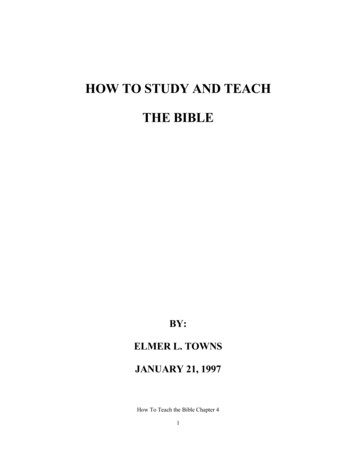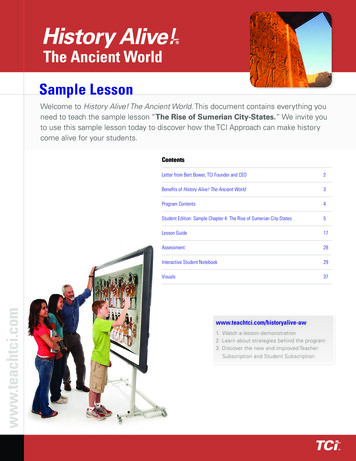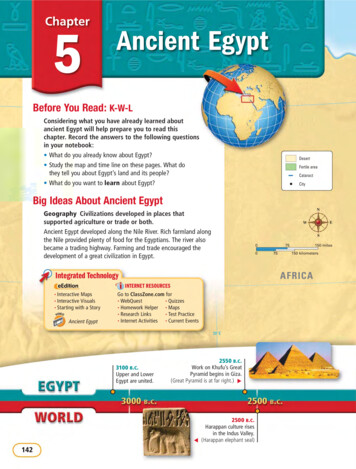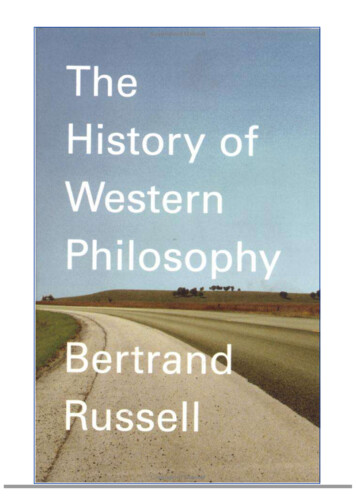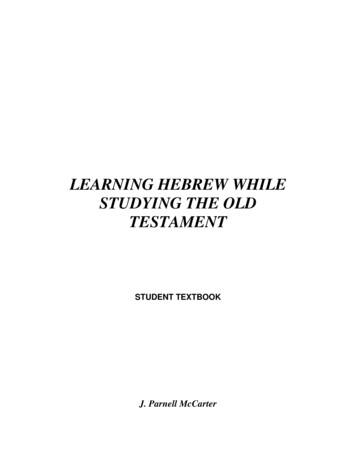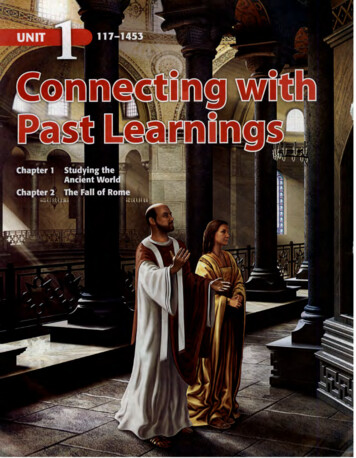
Transcription
California StandardsAnalysis SkillsHI 5 Students recognize that interpretations of history are subjectto change as new information is uncovered.English-Language ArtsWriting 7.2.4 Write Persuasive CompositionsReading 7.1.0 Students use their knowledge of word origins andword relationships, as well as historical and literary context clues,to determine the meaning of specialized vocabulary and to understand the precise meaning of grade-level-appropriate words.A Persuasive Composition In this chapter, you will readabout how scholars study the past by piecing clues together.You will pretend to be an archaeologist who has discoveredruins of a big building. In a letter, you will put together yourown set of clues and try to convince the reader about the
Focus on Themes To learn about history,to learn about many topics, including religion andyou must learn what historians do as they studysociety and culture. You will learn the differencethe past. As you read this chapter, you will learnbetween primary and secondary sources and seevocabulary that historians use and discover howhow our understanding of history changes as newthey use written and unwritten clues from the pastsources of each type are discovered .jSpecialized Vocabulary of HistoryAdditionalreading supportcan be found in theFocus on Reading Suppose you turned on the lV just in time tohear, "Depressed economic patterns indicate a downturn in consumerspending." Would you know that people are spending less money?lttter ti"eSpecialized Vocabulary The sentence in the previous paragraph uses specialized vocabulary, words used in only one field, economics. Historyhas its own specialized vocabulary. The chart below lists some termsoften used in the study of history.Reader andStudy GuideTerms used with dates· circa or c. a word used to show that historians are not sure of an exact date; it means "about"BCa term used to identify dates that occurred long ago, before the birth of jesus Christ, thefounder of Christianity; it means "before Christ." BC dates get smaller as time passes, so thelarger the number the earlier the date.ADa term used to identify dates that occurred after jesus's birth; it comes from a Latin phrasethat means "in the year of our Lord ." Unlike BC dates, AD datesget larger as time passes, so the larger the number the later the date.BCEanother way to refer to BC dates; it stands for "before the common era"CEanother way to refer to AD dates; it stands for "common era"I1I"" ' .,·'!!Because historians deal with so many dates, they have created many waysto refer to events in the past. For example, the time line below shows thatthe 1 OOs can also be called the second century. What do you notice aboutthe names given to a century and the first number of the dates in it?100 BC100 BCE4AD 2000BC 1 ADFirst century BCCHAPTER 11BCE 1 CEFirst century100 CE200 CE2000 CETwenty-firstcenturyAD 21002100 CE
You Try It!Chapter 1As you read this textbook, you will find many specialized vocabularyterms that historians use. Some of these terms will be highlighted inthe text and defined for you as key terms. Others may not be highlighted, but they will still be defined. You may find a few words, however, that you do not know and that are not defined. In many cases,you will be able to figure out what these words mean from clues inthe text around them. For an example, read the passages below andanswer the questions that follow.history (p. 6)primary source (p. 7)secondary source (p. 7)archaeology (p. 8)fossil (p. 8)artifacts (p. 8)Section 1Section 2society (p. 10)social structure (p. 13)Vocabulary in Context1. Artifacts also offer clues. These items cantell us about economic systems. Archaeologists may find Roman coins in Chinaand Chinese coins in Rome. If the coinsare from the same time period, we canconclude that the Romans and Chinesewere doing business at a certain time.2. Wrecks of Roman ships were recentlyfound far off the Mediterranean coast.Scholars had thought that the earlyRoman traders sailed their ships close tothe coast. The new finding suggests thatsailors could navigate the open watersearlier than experts had thought.FromChapter 1,pages 11,13-14Academic VocabularySuccess in school is related toknowing academic vocabularythe words that are frequently usedin school assignments and discussions. In this chapter, you will learnthe following academic words:cause (p. 7)effect (p. 7)purpose (p. 73)Answer the following questions.1.If you didn't know what economic meant, what clues in the firstpassage above might help you figure it out?2.What clues could help you guess the meaning of navigate in thesecond passage?3. In what century were you born? What is another name for it?4. Put the following dates in order: AD 2000, the third century,44 BC, the 1600s, CE 1215, 31 00 BCEAs you read Chapter 1, keep a list inyour notebook of specialized vocabularywords that you learn.STUDYING THE ANCIENT WORLD5
If YOU were there .Main Ideas1. Historians and archaeologists look for clues in writtenrecords and artifacts.2. Other sources of cluesinclude legends and luck.'You are spending your summer helping scholars search for thetomb of a great king. Local legends tell that the tomb lies under anearby hill, guarded by traps that will harm anyone who d isturbsthe king's resting place. A single coin bearing the king's name hasbeen found at the hill. However, an ancient scroll says that theking's body rests at the bottom of a deep lake, never to be found.The Big IdeaHistorians and archaeologistsstudy fossils, artifacts, andwritten records to learn aboutthe past.Key Termshistory, p. 6primary source, p. 7secondary source, p. 7archaeology, p. 8fossil, p. 8artifacts, p. 8Should you continue to search for the tomb?The st - fthe pa t co es- ; s many directions. What we hear, find, and read make up the pieces ofa very big and fascinating puzzle.aull.oiNG BACKGROUNDLooking for CluesThe task before you seems simple. You must fit together thepieces of a jigsaw puzzle to create a picture. But what if most ofthe puzzle pieces are missing, and you don't even know whatthe finished picture is supposed to look like?This is the task that we may face when we try to learn aboutthe past. To help us learn and to complete the picture, scholarsfrom two basic fields work together like detectives.What Historians DoThe main field that leads the investigation is histol'y'-the studyof the past. History isn't just about events that no one aliveremembers. It is both the distant and recent past. A battle thathappened 5,000 years ago and an election that happened yesterday are both part of history.Historians are people who study history. Historians are verycurious about the past. They want to know who did what. Theywant to know how, when, where, and why people did whatthey did.6CHAPTER 1
ArtifactsThe objects thatpeople created andused, like this Mayamask, can tell historians about theirculture, technology,and beliefs.FossilsWritten RecordsWritten records, like thisJapanese writing fromthe 1OOOs, are a valuablesource of informationabout the pastHistorians are interested in the wayindividuals lived. How did they work, fight,and worship? What did they do in theirfree time? Scholars also look at what groupsof people have done. What may cause anation to become powerful and then tofade away? Why did a new religion spread?What was the effect of an invasion?To study the past, historians mainly usewritten works. In the 5,000 or so years thatpeople have been writing, they have recorded laws, poems, speeches, battle plans, letters, contracts, and many other things. Inthese written sources, historians have founddetails about every aspect of human life. Inaddition, people have not been limited topaper and pens. They have carved messagesonto stone pillars, stamped them into claytablets, scribbled them on turtle shells, andtyped them on computers.The remains of early hominidscan give us clues about theirlifestyle. This skull from Africais about 1.8 million years old.Historical sources are of two types. Aprimary source is an account of an eventcreated by someone who took part in orwitnessed the event. Treaties, court records, ACADEMICand laws are primary sources. Diaries and VOCABULARYletters are too. An audio or video record- cause 0 make'somethmging of an event is also a primary source.happenA secondary source is information effect the resultof an action orgathered by someone who did not take part decisionin or witness an event. Examples includetextbooks and encyclopedias. The bookyou are reading right now is a secondarysource. The historians who wrote it did nottake part in the events described. Instead,they gathered information about theseevents from different sources. However, ifa historian writes an opinion about something, that opinion is a primary source. Theopinion is a record of how a historian at acertain time viewed history and the world.STUDYING THE ANCIENT WORLD7r.
What Archaeologists DoAnother field that contributes informationabout the past is archaeology (ahr-kee-AHluh-jee). Archaeology is the study of thepast based on materials that people haveleft behind. Archaeologists explore placeswhere people once lived, worked, fought,hunted, or pursued other activities. Inmany cases, objects that people left behindat these places provide the only clues wehave about their lives.For information on the very firsthumans, archaeologists examine fossilremains. A fossil is a part or imprint ofsomething that was once alive. Ancientbones and footprints preserved in rock areexamples of fossils.As human beings learned to makethings, they also happened to create moresources of information for us. They madewhat we call artifacts, objects created andused by humans. Among the many typesof artifacts are arrowheads, coins, tools,toys, jewelry, and pottery.Although individual artifacts can give ususeful clues, rrtore useful are groups of artifacts from the same area and time period.8CHAPTER 1Archaeologists refer to these collections ofrelated artifacts as a group's material culture.Just as important as the artifacts themselvesare the places where they are found. Forexample, Viking coins and swords foundin Russia can show that the Vikings tradedand fought there.Comparing How are thefields of history and archaeology similar?READING (HECKOther Sources of CluesHistorians and archaeologists work together.Archaeologists use written sources to helpthem find sites where they will find artifacts. Similarly, historians examine materialculture to help them understand what theyread. Sometimes these scholars also get helpfrom sources that may surprise you.LegendsStories and legends can point scholarstoward discoveries. For example, you haveprobably read stories about King Arthur.Historians know that no such king reallylived during the Middle Ages. However,
Khan, a mighty conqueror and ruler, tosearch for his tomb in his homeland ofMongolia. Archaeologists have found artifacts that suggest they are close to a majordiscovery, but so far Genghis Khan's tombhas not been found.LuckIn the 19705, archaeologists uncoveredthousands of clay soldiers built to protectthe tomb of a Chinese emperor. Scientistsare still studying the site's artifacts, suchas this warrior's head.legends about Arthur encouraged historiansto search ancient documents for information about England's distant past. In thesesources historians found a warrior wholived in about AD 500. This man may haveinspired the legends. Archaeologists, too,used the stories about Arthur as guides tomake important discoveries.Legends are still providing excitingclues that may lead to astonishing finds.For example, researchers in many fields areusing legends about the burial of GenghisSometimes luck can play a major part inuncovering history. In 19 74 Chinese farmers were digging a well. When their shovels hit hard clay instead of dirt, they wereamazed to find the first of the clay soldiersyou see on these pages.One day, perhaps you will make anamazing discovery or uncover new information that will explain what happenedlong ago. Perhaps you will even solve oneof history's mysteries.Evaluating Do you thinkthat legends and luck are reliable sources ofclues? Why or why not?SUMMARY AND PREVIEW Historians andarchaeologists use clues from manysources to learn about the past. Next,you will learn about some of the thingsthey can discover by using the e clues.Section 1 AssessmentReviewing Ideas, Terms, and PeopleCritical Thinking1. a. Define What is history?3. Categorize Copy the diagram.In the empty circles, list the typesof clues that historians andarchaeologists use.b. Contrast How is a primary source differentfrom a secondary source?c. Predict What kinds of things will future archaeologists study to learn about how we lived?2. a. Describe How do legends help historians?b. Explain Why would archaeologists studywritten sources and historians study artifacts?c. Rank List the ways in which scholars look forclues, ranking the methods from what you thinkwould be the most useful to the least useful.4. Finding Your Ruins Choose a large, familiar building that you will discovertl as an archaeologist,such as your school, a place of worship, or a shopping mall. Write down or draw pictures of what yourbuilding could look like 3,000 years from now.11STUDYING THE ANCIENT WORLD9
If YOU were there .Main IdeasYou are an expert on an ancient Asian language. For years you1. Using the evidence they havegathered allows historiansto draw conclusions aboutsocieties in the past.2. Views of the past changebecause of new discoveriesand new interpretations.have worked at translating a long poem from that language intoEnglish. Now it is finally finished! The poem seems to be just agroup of fairy tales, but you suspect that you can f1nd some real'The Big IdeaHistorians and archaeologistsput written and unwritten cluestogether to learn about thepast and sometimes to revisetheir ideas about the past.Key Terms·Ifacts within the fantastic stories. You want to know about thepeople who told the tales as they sat around their campfires.What else can you learn from these tales'?'- :pc "".C .c.;.· , ·h '.,.-, · - · ,., LBUILDING BACKGROUND The people who wrote down thesestories didn't know that they were telling later generations aboutthemselves. Yet that is just what they did. These unknown peoplewere creating evidence that we can use to understand the past. ,s·: cllilsociety, p. 10social structure, p. 10Using the EvidenceArchaeologists, historians, and other experts ask questions aboutthe past. Then they gather clues and put them together to revealinformation about past societies. A society is a community ofpeople who share a common culture.Social Structure and Family LifeFamilies are an important part of a culture's social structurethe way a society is organized. We often learn about family lifeand social structure in sources that are more about somethingelse. For example, you may remember a work of literature calledthe Rig Veda from last year's study of ancient India. This workof literature is mainly about religion. It also tells, however, thatIndian society was strictly divided into classes. Another text fromIndia, the Ramayana, tells us about marriage in early Indian society. In this story, Rama and his wife Sita face many dangers. InSita's constant loyalty, we see what the Indians considered to bea perfect wife. 10CHAPTER 1
Art can tell us about social structure andfamilies, too. For example, Egyptian tombpaintings show the pharaoh at the top ofEgyptian society and the other classes belowhim. Other paintings show the pharaoh athome with his wife and children. In thesescenes we see the importance of family tothe Egyptians.Politics and Economic SystemsAncient sources also inform historiansabout political and economic systems.Written sources can be especially useful forlearning about politics, or government. Forexample, many speeches of politicians fromancient Athens have survived in writtenform. Today, we can read those speechesand see that the Athenians valued democracy and that politicians worked hard toprotect people's freedoms.Some written sources are useful foranswering questions about a society's economic situation-the value of its goodsand services. Many cultures left behindbusiness records showing the value of different products. Other lists tell us howmuch workers were paid for various tasks.Artifacts also offer clues. These itemscan tell us about economic systems.Archaeologists may find Roman coins inChina and Chinese coins in Rome. If theAbove the kingis the Tree ofLife, and atopthe tree is abird that symbolizes heaven.The king is fallingfrom the Tree ofLife and beingswallowed by theearth monster,symbolizing hisjourney into theunderworld andafterlife.coins are from the same time period, we Focus ONcan conclude that the Romans and Chi- READINGwords givenese were doing business at a certain time. Whatyou clues to theWe may also find the actual items meaning ofthat people traded. Ancient North Amer- politicians?ica provides an example. Centuries ago,people used a rock called obsidian (uhbsr-dee-uhn) for making weapons. But fewsources of obsidian existed. Archaeologistshave found obsidian weapons hundreds ofmiles from the stone's sources. Using thisinformation, experts can calculate how fartrade in the valuable rock extended.STUDYING THE ANCIENT WORLD1-1
LanguageLearning about ancient languages can beespecially difficult for historians. Whenscholars find a document in an unknownlanguage, they don't find a dictionary forthat language right next to it!Sometimes historians can use cluesfrom known languages to understand oldones. The most famous example is theRosetta Stone. Created in ancient Egypt,the Rosetta Stone shows the same message in Greek and in two types of Egyptianwriting. Because scholars could read Greek,they were able to translate the Egyptianwriting also. Since the early 1800s, whenits secrets were unlocked, the Rosetta Stonehas helped historians read many Egyptiantexts. Some ancient languages, however,are still complete mysteries.12CHAPTER 1Art and ArchitectureLooking at a society's art can tell us moreabout a society than just what its peopleliked to draw or paint. One thing art mayshow us is religious beliefs. For example,you probably remember that archaeologists have found Egyptian tombs full ofbeautifully crafted furniture, jewelry, toys,and other everyday items. The fact thatthe Egyptians placed these goods in tombsshows they believed the person buriedthere would need them. From this evidence, we can conclude that the Egyptiansbelieved in life after death.Art can also give us clues about a society's level of technology. Do you remember the Shang dynasty of China? Althoughthere are gaps in our knowledge of thatlong-ago time, we have found beautifulbronze objects that are amazing for theirdetail. These art objects show us that theShang had incredible metalworking skill.Architecture provides more evidenceabout societies. Clues come from the number and types of buildings. For example,if archaeologists find many temples in theruins of a small town, they can assumethat religion was very important there. Or,if none of the houses in a place were fancier than others, they may figure that noone was much richer than anyone else.The structure of the buildings themselves can reveal clues, too. If an ancientcastle had thick stone walls, perhaps warwas a problem, and the people needed wallsas protection from enemies. The beautifultemples that the Greeks built show theimportance of the Greek gods. Similarly,buildings made with rounded arches showus the Romans' engineering talents.Beliefs and ValuesFinally, historians and archaeologists usemany sources to interpret the beliefs andvalues of a society. Written sources like the
tteachings of Confucius tell us about theimportance of the family to Chinese society. The Code of Hammurabi tells us thatthe Babylonian ruler of long ago valuedjustice. Written speeches show that theearly Romans thought highly of citizenswho served the republic.Unwritten sources also provide information. Greek statues of athletes andimages of athletes on vases show the valuethat the Greeks placed on sports. Unwritten sources can be harder to interpret,however. Sometimes archaeologists findartifacts whose purpose is unclear. Often,experts think these unidentified objects arerelated to religious beliefs. Other expertsdisagree. To understand the cultures thatcreated these mysterious objects, we mustfind more information.Generalizing What typesof information can evidence reveal about pastsocieties?Views of the PastAlthough we have evidence from manysources, our understanding of historychanges. Archaeologists may find newclues that change what experts think abouta society. In addition, changes in our ownsociety may alter our ideas about history.New Discoveries ,New historical evidence can change ourunderstanding of when events happened.In recent years, archaeologists have foundACADEMICextremely old human bones in Africa and VOCABULARYthe Americas. These remains may require purpose use orthe time lines of human development to functionbe completely rewritten.Another example comes from the bottom of the Mediterranean Sea. Wrecksof Roman trading ships were recentlyfound far off the Mediterranean coast.Scholars had thought that early Romantraders sailed their ships close to the coast.
The site of Troy isa popular touristattraction forTurkey.people had read Homer's tales about theThe new finding suggests that sailorsTrojan War in the Iliad and the Odyssey.could navigate the open waters earlierMost people assumed they were just stothan experts had thought.ries. Schliemann, however, thought theyHow we view a society can also changewith new archaeological finds. Not longdescribed real events in a real place. Afteryears of searching and digging, Schliemannago, historians thought the Maya of CentralAmerica were a peaceful people interestedfound a whole civilization that no one knewmainly in studying the stars and makinghad existed. He also found the site of Troy.art. When scholars figured out how to readNew Interpretationsmore Maya writing, however, they foundthat Maya rulers often made war on theirViews of history also change depending onneighbors. Scholars also learned that Mayathe time, place, and cultures within whichhistorians live. The growth of democracy,religion included cruel, bloody rituals.New evidence can even shed new lightthe civil rights movement, and women'son old stories. Heinrich Schlieman? (SHLEE- ] movements have affected how we studymahn) and his search for the city of Troyhistory. In the United States,, for example,·serve as a good example. For centuries,we now realize that women played key roles , 14CHAPTER 1
As you study world history, think critically about what you learn, and be ready forchange! Because new evidence can appear,and-because our own culture shifts, a historian must keep an open mind. Consider newevidence carefully, and be prepared to reviseyour understanding of history.l; fr1 l!Ui i!33i* Analyzing Why do views ofhistory change?SUMMARY AND PREVIEW Artifacts andwritten evidence help archaeologists andhistorians study and reconsider manyaspects of past societies. In the nextchapter you will study what historiansand other scholars have learned aboutthe fall of the Roman Empire.Reviewing Ideas, Terms, and People1. a. Define What is a society?in history. In the past their contributionsreceived little attention, but today manyhistorians study women in history-bothas a large group and as individuals.The attention historians have paidto rich and powerful people versus ordinary or poor people is another example ofchanging views. Once rich and powerfulpeople got almost all of the attention inhistory books. Now historians also look athow ordinary people lived.Personal opinions of historians can alsoaffect their views of the past. Political opinions, for example, can make historians seepast times in certain ways. Historians mustalways be careful not to let their personalbiases affect their work.b. Explain What could price lists and lists of workers'wages tell us about a people's economic system?c. Evaluate What type of evidence do you think would bethe most difficult to interpret? Why?2. a. Identify What are two ways interpretations of historyhave changed?b. Explain Why should historians watch out for personalbiases?Critical Thinking3. Identifying Cause and EffectCopy the graphic organizer.Use it to describe what wemay learn about a culture aftera historian figures out how toread an ancient language.A historian discovers how toread an ancient language.OlDD4. Analyzing the Evidence What can you learn about thepast from the ruins you have found? What can variousparts of the building tell you? What can you learn from thematerials and arrangement of the building? Draw a mapof your building and label important uclues:'STUDYING THE ANCIENT WORLD
Understanding Historical InterpretationC) Determine if the writer or speaker has ignoredHistorical interpretations are ways of explaining thepast. They are based on what is known about thepeople, ideas, and events that make up history.Two historians can look at the same set of factsabout a historical topic and see things in differentways. For example, historians decide which facts arethe most important in explaining what happenedand why. One person may believe certain facts areimportant, while someone else may believe otherfacts are more important. The amount of attentionpaid to different facts can lead historians to comeup with different explanations of what happened inthe past and why it happened.The result of focusing on different facts is different interpretations of history. In addition, if newfacts are uncovered about a topic, they may causehistorians to reconsider their ideas, and still morehistorical interpretations may result. Being able torecognize and evaluate different historical interpretations is a valuable skill in the study of history.important information about the topic. If so, theinterpretation may be inaccurate or deliberatelyslanted to prove a particular point of view.Just because interpretations differ, one is notnecessarily "right" and others "wrong." As long as aperson considers all the evidence, and draws conclusions based on a fair evaluation of that evidence,his or her interpretation is probably acceptable.Remember, however, that trained historians letthe facts lead them to conclusions. People who startwith a conclusion, select only facts that support it,and ignore opposing evidence produce interpretations that have little value for understanding history.Reread the "If you were there" scenario in Section1. Suppose that Historian A believes the king's bodyis in the hill, and Historian B believes it is at thebottom of the lake. Answer the following questionsto evaluate their explanations of what happened tothe king.1. Is the coin strong evidence to support HistorianA's interpretation? Explain why or why not.Use the following guidelines to better understandand evaluate differing historical interpretations ofpeople and events.2. Should Historian B ignore the local legend? If so,03. Suppose each historian asks you to be part ofIdentify the main idea in how the topic isexplained. What conclusions are reached? Conclusions may not be directly stated. They mayonly be hinted at in the information provided.E) Identify the facts on which the writer or speakerhas relied. Do these facts seem to support his orher explanation and conclusions?l6CHAPTER 1why? If not, how should he or she handle it?their expedition to find the king's body. Whichhistorian's group would you join? Explain why.4. Suppose one day the group digging in the hillfinds pieces of pottery like those that were usually put in the grave of an important person.How might this discovery affect explanations ofwhat happened to the king?
Standards ReviewUse the visual summary below to help you reviewthe main ideas of the chapter.Using clues,historians studythe past.They study people's culture, technology,beliefs, and accomplishments.Reviewing Vocabulary,Terms, and PeopleChoose the letter of the answer that best completes eachstatement below.1.is the study of the past.a. Archaeologyc. Societal structureb. Literatured. History2. A magazine article about an event that hap-pened 100 years ago would be considered a(n)a. elementary source. c. primary source.b. secondary source. d. artifactual source.3. A tooth from an ancient human skeleton is a(n)a. fossil.b. remnant.c. artifact.d. document.4. The study of the past based on materials that5. An example of a primary source is a(n)a. textbook.b. encyclopedia.c. journal entry.d. dictionary.6. Jewelry, tools, toys, clothing, and broken dishesmay be examples ofa. fossils.b. primary sources.c. social objects.d. artifacts.7. If a historian studies how two events areconnected, he may be studying thethat one event had on the other.a. effectc. purposeb. caused. change8. A community of people who share a commonculture is aa. town.b. country.c. society.d. social group.people have left behind isa. history.c. biology.b. archaeology.d. geography.STUDYING THE ANCIENT WORLD1.7
Comprehension andCritical ThinkingSECTION 1 (Pages 6-9)9. a. Identify What two types of scholars gatherclues to study the past?b. Analyze What more could an archaeologistlearn from studying a group's material culturethan from just studying an artifact?c. Evaluate Do archaeologists or historians havea more difficult job? Why?SECTION 2 (Pages 10-15)10. a. Describe What do scholars need to be able tointerpret old languages?b. Analyze Why do changing perceptions aboutour society today affect history?c. Elaborate What may an archaeologist conclude about a society if the weapons she foundin a ruined city were well made but the farmtools were poorly made? What might cause herto change her conclusion?Reviewing Themes11. Society and Cult
As you read this textbook, you will find many specialized vocabulary . STUDYING THE ANCIENT WORLD 5 . . certain time viewed history and the world. happen effect the result of an action or decision STUDYING THE ANCIE
